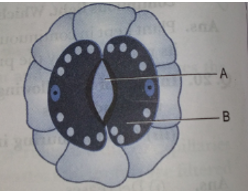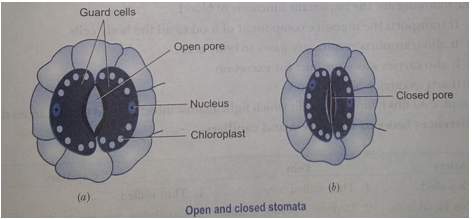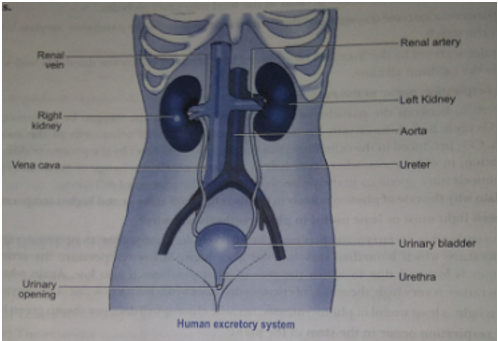Short Answer Questions - II - 3 Marks
Que 1. What are the adaptations of leaf for photosynthesis?
Ans. (a) Leaves provide large surface area for maximum light absorption.
(b) Leaves are arranged at right angles to the light source in a way that causes overlapping.
(c) The extensive network of veins enables quick transport of substances to and from the mesophyll cells.
(d) Presence of numerous stomata for gaseous exchange.
(e) The chloroplasts are more in number on the upper surface of leaves.
Que 2. Mention the major events during photosynthesis.
Ans. The major events during photosynthesis are:
(a) absorption of light energy by chlorophyll
(b) conversion of light energy to chemical energy
(c) splitting of H2O into H2, O2 and energy
(d) reduction of CO2 to carbohydrates
Que 3. Study the given diagram:
Name the parts 'A' and 'B' and state one function of each.

Ans. A → Stomatal pore
Function: Massive amounts of gaseous exchange takes place in the leaves through these pores for the purpose of photosynthesis.
B → Guard cell
Function: The opening and closing of the stomatal pore is a function of the guard cell.
Que 4. What substances are contained in the gastric juice? What are their functions?
Ans. Gastric juice contains three substances: hydrochloric acid, enzyme pepsin and mucus. Their functions are:
(i) Hydrochloric acid in the stomach is used to make the medium acidic to facilitate the action of the enzyme pepsin and to kill germs if any.
(ii) Enzyme pepsin digests proteins to convert them into peptones.
(iii) The mucus helps to protect the stomach wall from its own secretions of hydrochloric acid.
Que 5. What are the various processes that take place in the duodenum?
Ans. processes that take place in the duodenum are:
(i) Bile emulsifies the fat molecules present in the food into small globules.
(ii) The pancreatic enzyme trypsin starts digesting the proteins and the pancreatic amylase breaks down the starch.
(iii) Bile juice secreted by the liver and bicarbonate ions are secreted by the duodenal wall which makes the medium alkaline.
Que 6. How does respiration occur in the roots of the plant?
Ans. Air is present in between the particles of the soil. The roots take the oxygen by the process of diffusion. Oxygen first diffuses into the root hairs and reaches all other cells of the root for respiration. CO2 produced in the cells moves out through the root hairs by the the process of diffusion. For respiration, in older roots, where root hair is not present, the exchange of gases takes place through lenticels (tiny openings in the protective layer) by the process of diffusion.
Que 7. (i) Explain why the rate of photosynthesis in plants is low both at lower and higher temperatures.
(ii) Is green light most or least useful in photosynthesis and why?
Ans. (i) Photosynthesis is an enzymatic process. The enzymes function within an optimum range of temperature which is neither very low nor very high. At low temperature the activity of enzymes is lowered due to which the rate of photosynthesis is also low. Again when the temperature is very high, the activity of enzymes decreases which leads to low rate of photosynthesis.
(ii) Green light is least useful in photosynthesis, because chlorophyll does not absorb green light.
Que 8. How does respiration occur in the stem of the plant?
Ans. In the stem of herbaceous plants, stomatas are present. So, the exchange of gases takes place through stomata by the process of diffusion. In the woody and hard stems of big plants, the exchange of gases takes place through lenticels which are present on the bark of the stem.

Que 9. Give reasons:
(i) Plants look green.
(ii) The respiratory surface of earthworm is its skin.
(iii) Nutrition is necessary for an organism.
(iv) We boil the leaf in alcohol when we are testing it for starch.
Ans. (i) The leaves of plants contain green pigments called chlorophyll which is necessary for photosynthesis. Plants reflect green light of sunlight, so they look green.
(ii) The skin of earthworm is quite thin and moist and has rich blood supply. So, it respires through its skin.
(iii) An organism requires nutrients like carbohydrates, fats, protein, minerals and vitamins for the growth, reproduction and metabolic activities, so nutrition is necessary for an organisum.
(iv) We boil the leaf in alcohol to remove chlorophyll from green leaf.
Que 10. Draw and label the parts of the human excretory system.
Ans.

Que 11. State the function of the following components of transport system:
(i) Blood (ii) Lymph
Ans. (i) The following are the important functions of blood:
(a) It transports the digestive component of food to all the body cells.
(b) It also transports respiratory gases to body cells.
(c) It also carries waste product for excretion.
(d) It acts as carrier of hormones.
(ii) Lymph contains lymphocyte cells which fight against infection and it also carries digested fat.
Que 12. State differences between artery, vein and capillary.
Ans.
|
Artery |
Vein |
Capillary |
|
1. Thick-walled. 2. Carries blood from the heart to other parts of the body. 3. Situated deeper under the skin. |
1. Thin-walled. 2. Carries blood from different organs to the heart. 3. Situated just under the skin. |
1. Thin-walled. 2. Capillaries are involved in the exchange of food material, respiratory gases, and body wastes. 3. Occur at the terminals of artery and vein. |
Que 13. Is 'nutrition' a necessity for an organism? Discuss.
Ans. Food is required for the following purposes:
(i) It provides energy for the various metabolic processes in the body.
(ii) It is essential for the growth of new cells and repair or replacement of worn out cells.
(iii) It is needed to develop resistance against various diseases.

